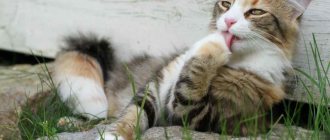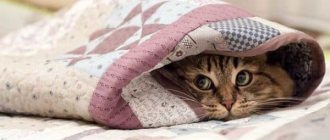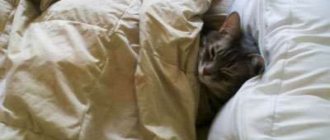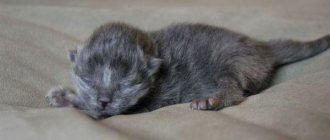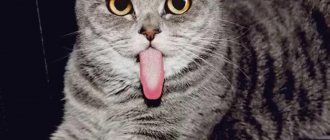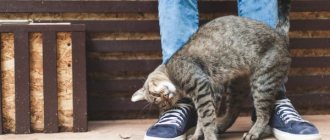What affects how long a cat sleeps?
The duration and quality of an animal's sleep depend on a number of reasons:
- Age. Young kittens and adults sleep more than middle-aged kittens.
- Breed. Representatives of the Scottish and British breeds especially like to nap. They usually go to rest immediately after eating. Abyssinians, due to their high activity, have less need for this.
- Health and stress. Sick animals sleep less than healthy ones, and their sleep is also more sensitive.
- The situation in the housing. There may be sleep disturbances if the animal experiences discomfort or if one of the family members disturbs it.
If the pet is absolutely healthy and does not experience fear or fear of anything, it will sleep at least 12 hours a day. To create more comfort for him, you should purchase a special house in which he can retire from prying eyes.
After sterilization, a cat sleeps more than before. This occurs due to hormonal fluctuations. The production of certain substances that affect activity decreases or stops altogether, which often leads to excess weight gain and increased drowsiness.
Why do domestic cats sleep more than indoor cats?
Domestic cats sleep more than stray cats because they do not need to search for food. A barn cat may not receive food for several days in a row; in this state, it will direct all its efforts to solving problems with hunger.
Backyard animals are more susceptible to stress associated with the influence of the outside world. Sleeping undisturbed for a long time can be simply dangerous to life and health.
How cat breed affects sleep duration
Belonging to the breed determines the behavior, character and duration of sleep. This is due to the characteristics of the cat’s nervous system and temperament. Easily excitable breeds, such as Asians, Siamese, and Orientals, sleep less than average.
Cats with a phlegmatic temperament - Persians, Coons, and Scots - sleep more than average. The duration of sleep determines primarily the health status of the pet. the owner must monitor the behavior of his animal and pay attention to any deviations. There may be deviations if the animal has problems with its health.
If the cat suddenly becomes lethargic, sleeps a lot, refuses to eat, does not pet or play, problems with his health should be ruled out. It is worth seeking help from a veterinarian.
Serious reasons why a cat is lethargic
However, the lethargy of a pet should not be taken lightly: it happens that a cat is lethargic due to illness:
- Stress
. If the cat has become lethargic, it may be due to a mental disorder, which can occur in pets for various reasons, for example, when moving to a new home, changing owners, having a new pet in the house, or suddenly switching to new food. The main signs of stress in cats include lethargy (although in some cases the pet may look very agitated), refusal to eat or literally gorging, constant licking of fur (even to the point of bald spots), bad behavior (the cat marks and shits outside the tray, screams loudly, gnaws flowers, destroys furniture, etc.). As a rule, stress goes away on its own if you regularly communicate and play with the cat, but in some cases it is necessary to take sedatives; - Poisoning
. If the cat has become lethargic, trembles, breathes loudly and heavily, refuses to eat, has vomiting and/or diarrhea, saliva runs heavily, the mucous membranes have turned red or blue, the temperature has risen or dropped (normal temperature in adult cats is from 37.5 up to 39 degrees, for kittens - from 39 to 39.5 degrees), there is a suspicion that the animal has been seriously poisoned by something. What can cause poisoning in pets? Anything: rotten fish, houseplant juice, washing powder, rodent poison and much more; - Jumps in blood pressure
(very difficult to diagnose!). There is a possibility that the cat is lethargic all the time if she has low or high blood pressure, which normally ranges from 105/65 to 135/95 mmHg. Signs of high blood pressure include apathy, red eyes, dilated pupils, blurred vision (this can be calculated by observing an animal that will bump into walls or furniture when walking), noises during breathing, swelling of the extremities, vomiting, nosebleeds, high pulse (more than 180 beats per minute). Low blood pressure can be recognized by constant drowsiness, loss of appetite due to nausea, decreased heart rate (below 80 beats per minute), and loss of consciousness. If your pet has such symptoms, you need to quickly go to the veterinarian; - Endocrine disorders
. In some situations, a cat is lethargic due to diabetes mellitus or Cushing's syndrome. Plus, don’t forget about hormonal imbalance, which often occurs in pets after giving birth, and even after sterilization, a lethargic cat is common. You can figure out from the following symptoms that your pet has endocrine problems: extreme thirst, frequent urination, changes in appetite (the cat either begins to eat very little or constantly asks to be fed), deterioration in the condition of the coat and skin, an increase in the volume of the abdomen, weight fluctuations, cramps, heaviness of gait, blurred vision, low motor activity as a result of weakening muscles; - Diseases of the musculoskeletal system
, for example, osteochondrosis, arthritis, joint dysplasia, bone fractures, joint dislocations, ligament rupture. Find out that a cat has problems of this nature simply by the following symptoms: lameness, refusal to jump, change in gait, pain (the cat growls and bites if the owner touches the sore spot), swelling in the area of the affected joints, refusal to eat and apathy. Cats with diseases of the locomotor system often do not sharpen their claws, take poor care of their coats, and do not wash themselves; - Oncology
. If the cat is lethargic, lies down most of the day, eats very little or refuses food at all, is rapidly losing weight and meows pitifully, suffers from vomiting, diarrhea and internal bleeding, the development of cancer can be suspected. Other signs of cancer in cats include bad breath, the appearance of ulcers and minor swelling on the body (in some cases the tumor is visible to the naked eye), aimless wandering around the apartment; - Infectious diseases
. A cat is usually very lethargic with the following infectious diseases: calcivirosis, rhinotracheitis, leptospirosis, panleukopenia, immunodeficiency virus. Common signs of these illnesses include a rise in body temperature, refusal to eat, shortness of breath, cough, wheezing during breathing, vomiting and diarrhea (usually foul-smelling and greenish), changes in the color of mucous membranes, discharge from the nose and eyes; - Parasites internal and external
. We are talking about the most common uninvited guests - worms, ticks and fleas. Helminthic infestations are recognized by stool disorders (a cat may have diarrhea alternating with constipation), vomiting, weight loss, an increase in abdominal volume, flatulence and rumbling in the abdomen, bad breath, greenish discharge from the eyes. Ear mites can be identified by constant shaking of the head, the appearance of a large amount of dark sticky wax, and itching (the animal constantly scratches its ears). Ticks on the body provoke the appearance of wounds and scales on the skin, hair loss to the point of baldness, and constant itching. Other parasites, fleas, manifest themselves in much the same way. Many owners fight worms with deworming agents, and use insectoacaricides to eliminate skin parasites, but before using such products it is better to consult a specialist; - Inflammatory diseases of internal organs
. Almost any inflammation is guaranteed to cause apathy in the cat and a refusal to play. So, a cat can be sad, for example, with gastritis or colitis, pancreatitis, cholecystitis, pyelonephritis, stomatitis, myocarditis. There are plenty of inflammatory diseases, so it’s difficult to name general symptoms. With inflammatory diseases of the gastrointestinal tract in animals, stool disorders and vomiting, bloating, flatulence, blood in the stool, and fever are observed. If there are problems with the urinary system, the cat is lethargic and does not eat for several days or eats but little, there will probably be thirst and pain during urination. If the heart is affected, the pulse will rise above normal and shortness of breath will appear. And if the cat’s mouth is inflamed, the cat will salivate heavily, the gums will become red and swollen, and the appetite will decrease or disappear; - Hypovitaminosis
. Lethargy can also be caused by a lack of vitamins, for example, with a poor, monotonous diet. Animals with this problem are often inferior in height to their counterparts, they have dull hair and poor skin condition (dermatitis, dandruff), females often have miscarriages, and have problems with bowel movements; - Anemia
. If the production of hemoglobin and red blood cells is disrupted, almost all purrs experience weakness, cyanosis of the mucous membranes, shortness of breath, a drop in blood pressure, pulse fluctuations, and deterioration in the quality of the coat; - Dehydration
. With a lack of water in the body, the cat is lethargic and the nose is dry, the skin loses elasticity, the eyeballs look sunken, the mucous membranes dry out, saliva becomes sticky and viscous, and the pads of the fingers are cold to the touch. A cat in this state does not eat and hardly drinks, although it desperately needs water. If the animal cannot be given water even by force, you should immediately contact the clinic, where the doctor will prescribe an infusion of electrolyte solutions subcutaneously or intravenously; - Foreign body in the pharynx or elsewhere in the gastrointestinal tract
. If the cat is lethargic and does not drink, and also refuses to eat, it often vomits and salivates profusely, its voice becomes hoarse, there is a possibility that something is stuck in the throat or elsewhere in the gastrointestinal tract, for example, a fish bone or small part from a toy; - Various complications after surgery
(suppuration or suture dehiscence, postoperative hernia, etc.). If the cat appears lethargic after surgery during the first 1-3 days, then there is nothing to worry about, provided that the animal drinks water and shows at least minimal interest in food. Fever, plaintive meowing, blood or pus from a postoperative wound, constipation, vomiting are reasons to immediately contact the clinic.
How and where is the most comfortable place for a cat to sleep?
The pet chooses a secluded, quiet and peaceful place to sleep, where no one will disturb him. It is worth purchasing a house with soft walls and a bottom. Here the cat is comfortable and safe. But it has been correctly noted that cats can comfortably sleep almost anywhere. If an animal feels safe, well-fed, and healthy, it will definitely not have any problems finding a place to sleep.
Observing behavior, owners ask questions related to their cats' sleep. For example, why does a cat sleep with its eyes open? If this is noticed, you should not frighten or wake the animal. This natural state for a cat's sleep is indicative of a shallow, pleasant slumber, especially in older pets.
Sleeping with your eyes open, accompanied by symptoms of paralysis, should alert you. It is dangerous if the animal’s eyes become cloudy, convulsions are observed, and the breathing rhythm is disrupted.
A cat loves to sleep on its owner's stomach for a number of reasons. In some cases, she may feel early pregnancy. Some furry owners say that the animal sensed pregnancy before they knew about it themselves.
Sometimes the cat tries to improve the owner’s well-being in this way. It is possible that the furry one intuitively senses health problems. Some owners and even experts are confident that a cat lying on its owner’s stomach can relieve stress and improve his mood. In this case, the animal tries to position itself closer to the solar plexus.
Why does a cat sleep on its head? Many people think that this is a bad sign. In fact, in this way she is trying to express her devotion and love for the person. The cat may feel a headache and makes attempts to relieve it.
Sometimes the cat begins to exhibit strange behavior, which raises some questions for the person, such as why the cat sleeps in the litter box. This can happen for a number of reasons:
- has difficulty using the toilet, has problems with urination;
- does not have a secluded place to sleep;
- it's just a bad habit that needs to be broken.
In the first two cases, you should contact a veterinarian. In other cases, it will be enough to provide your pet with a comfortable place to sleep, taking care of its convenience and comfort.
A cat sleeps on its back for a number of reasons:
- the ambient temperature is too high and the animal is simply too hot;
- love and trust in the person and everyone living in the apartment;
- problems with organs located in the groin area;
In the latter case, it is worth observing the animal, its behavior, and whether the cat is experiencing difficulties with urination. In case of deviations, you should seek veterinary help.
Symptoms of a kitten's restless sleep
A large amount of sleep in cats, and especially kittens, should not be a cause for concern unless there are suspicious symptoms.
Usually the sleep of kittens and adult cats is calm and even, but you should pay attention if the sleep can be called restless.
1. Breathes frequently when sleeping. Very little babies should take about 50 breaths per minute. If this indicator is higher in a dream, then it is worth observing to understand the source of the problem. Most likely there is nothing to worry about, and the kitten is emotionally disturbed by what is happening in his dream.
2. Shakes when sleeping. There can be several reasons: from harmless ones (previously experienced stress or an uncomfortable position) to those that are worth paying attention to (the kitten gets sick and needs the help of a specialist).
3. Sleeps with eyes open. In babies under 1 year of age, the “facial” muscles may be underdeveloped. This often results in eyelids opening slightly during sleep. However, by the age of one year the “deviation” goes away on its own.
Kittens often twitch when they sleep. The kitten seems to be having trouble sleeping. But in reality, this is not always a reason to worry. Most likely, the baby is in the rapid phase of sleep, which means he sees dreams in which he happily runs and jumps.
Kittens often dream, so sleeping babies can move their paws, meow and show other activity.
If you are in doubt, it is better to contact a veterinarian for a more thorough examination of your pet.
Changing your sleep pattern: when to be wary
Sometimes a cat sleeps all day and starts playing at night, thereby disturbing people. Most predators are nocturnal animals, accustomed to being active in the dark. The most common domestic cat is a distant relative of tigers or panthers. They have similar habits, habits, and behavior patterns.
Material on the topic: everything about the Russian Blue cat breed.
In this case, it is worth adjusting your daily routine. This may take from a couple of days to several weeks. First of all, it is important to follow a diet. Try in every possible way to prevent your pet from sleeping during the day. Often they doze off because they are simply bored.
If a person pays little attention to them and does not play with them, the cat has no outlet for its energy and chooses to simply sleep. It is important to play with her more often, to try to realize her hunting instincts in a playful way. The pet needs to throw out its energy, which will ensure a healthy, sound sleep at night for all family members. Well, what if the fluffy dormouse just likes to take a nap for an hour or two. You shouldn't disturb her.


